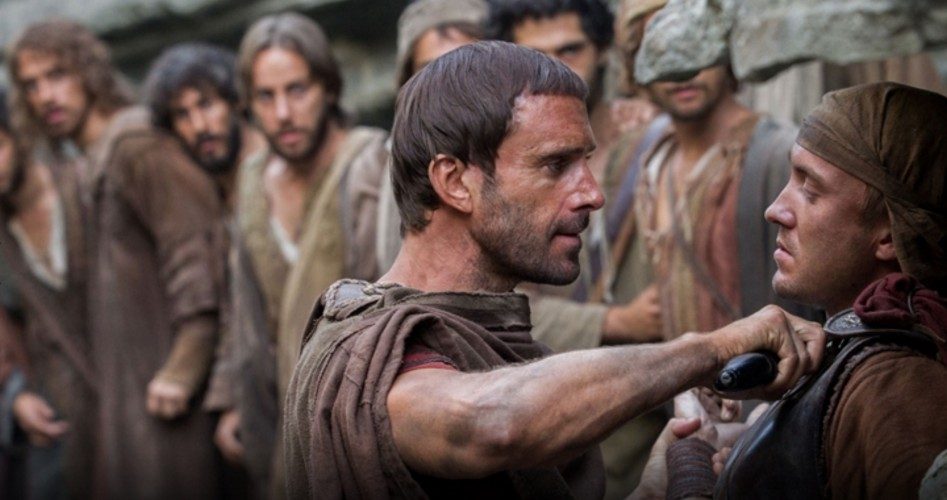
With as many films as have been made about the Crucifixion and Resurrection of Christ, attempting anything like a new take on “the greatest story ever told” is an ambitious undertaking. Kevin Reynolds, who wrote and directed Risen, attempted just that and — despite a few hiccups — did an admirable job of it.
Risen looks at the stories surrounding the Resurrection from the perspective of a Roman military tribune who is tasked by Pontius Pilate with finding the corpse of Yeshua (Jesus), which the Roman and Jewish leaders suspect was stolen by his followers to perpetuate the myth that he has risen from the dead. It is that interesting premise — a Roman military investigation into the missing body of a controversial Jewish religious leader — that makes Risen different from the plethora of other films about the real story of Easter.
From its opening scene, Risen does a masterful job of portraying the subtleties of life in first century Palestine, from dusty deserts to the precarious political balance of a far-flung Roman outpost populated by an unruly and zealously religious semitic people bent on liberation and troubled by both religious and political uprisings.
Reynolds departs from the status quo — present even in Mel Gibson’s Passion of the Christ — of portraying all Romans (especially the soldiers) as brutal oppressors devoid of any sense of morality or conscience. Instead, Risen presents Roman soldiers and citizens much as any other group of people throughout history: as individuals, with each possessing his or her own personality and moral compass. Some soldiers are driven by a sense of duty. Others are driven by ambition. Still others have no drive whatsoever but are instead lazy and in need of nearly constant supervision. I suspect that any officer commanding a group of American soldiers today in the deserts surrounding Palestine would describe his soldiers the same way. Reynolds — by adding this very real human element — offers the viewer an opportunity to connect with the struggles and hopes of the Romans who occupied the Holy Land at the time of Christ. Even Pilate (played by Peter Firth) is shown as a troubled man living in troubled times and facing a no-win situation.
Clavius (the tribune who seems to be Pilate’s go-to guy) is driven by both duty and ambition. He takes his job seriously and performs it well. In the first few minutes of the film, he is sent to put down a budding insurrection led by Barabbas. He commands his soldiers with the precision of a surgeon and the detachment of an officer who has seen the horrors of battle before. Even still, Clavius (played by Joseph Fiennes) seems tired of it all. He does his job and his patriotic duty, but he doesn’t revel in it.
Even the act of crucifying dangerous criminals is seen more as a necessary evil than as a cause for joyous celebration. It could almost be seen as Rome’s peculiar institution. Reynolds draws subtle (and sometimes not-so-subtle) comparisons between first century Roman treatment of “dangerous radicals” and 21st century treatment of “suspected terrorists” at the hands of America and her allies. Describing crucifixion, Clavius says that the crucified have to choose their torment by shifting their weight from the nails in their arms to the nails in their feet. He also says that every breath “is like sucking air through a wet cloth” — a clear reference to waterboarding.
The film does not show the Crucifixion. But upon his return from squelching the rebellion, Clavius is sent by Pilate to “see that the Nazarene is dead.” No rest for the weary. The scene shows a variety of reactions from various characters. The Blessed Virgin Mary and those with her are in the deepest sorrow. The crowd that demanded the death of the King of Kings is still angry. The soldiers are shown doing their duty with varying reactions ranging from revulsion to clinical detachment. Christ is dead and the thieves — both the penitent and the recalcitrant — are languishing in pain. Clavius, mindful of the need to finish the job quickly, commands the soldiers to break the legs of the crucified thieves and pierce the side of the dead Nazarene with the same military precision he exhibited earlier in the day.
After the soldiers Clavius posts at the tomb fail and the body of Yeshua goes missing, Pilate blames the tribune and assigns him to find the corpse before the rumor of his Resurrection gets out of hand. The Jewish leaders are concerned and Pilate is trying to maintain an impossible balance. If the body can’t be found before it decomposes, there is little hope of putting this whole matter to rest.
So, Clavius begins his investigation by trying to hunt down the followers of Yeshua. He leans on informants, questions suspects, and follows leads. He keeps at his task, missing sleep and fighting a deadline in his manhunt for what he believes is a decaying corpse. He plays rough with suspects and threatens them with torture and crucifixion. It’s a little like watching Danny Reagan trying to solve a case before time runs out.
When he finally finds the risen Christ (I figure that 2,000 years and almost as many movies keep that from being a spoiler), his beliefs are shaken to the core. The same Yeshua (played oddly enough by Cliff Curtis from The Walking Dead) he saw dead on a Roman cross is living, breathing, eating, and talking with his followers.
Yeshua is little more than a supporting character in Risen, as the story is really about Clavius and his investigation. Frankly, that’s just as well. In what is probably the most glaring weakness of the film, Yeshua and his followers come off as disconnected from reality. Even while being interrogated and threatened with a torturous death, the Apostles can’t seem to wipe the ear-to-ear grins from their faces as they answer life-and-death questions with casual flippancy. Yeshua grins and whispers to his followers like he’s enjoying a private joke at the expense of poor Clavius who can’t seem to get his head around what he is seeing.
Risen has other shortcomings, as well, but none that approach the scale of ruining an otherwise good film. The battle scenes, though well acted and directed, are far from epic with a few Roman soldiers on one side and a few insurrectionists on the other. There are minor scripting issues (the word crusade is used figuratively a full thousand years before it would be used literally). The Ascension is presented without Christ actually ascending. Instead, it’s shown as a sort of thermonuclear event, perhaps for the purpose of dazzling moviegoers with Hollywood’s version of special effects. But the movie’s shortcomings don’t keep the film from delivering its message and quite a punch.
The message of Risen is tied inexorably to the fact that 2,000 years ago in a small outpost of a small corner of the Roman empire, a small band of men and women followed a religious leader who was crucified because Rome feared that any unrest could upset the delicate balance of Roman rule over the known world. Rather than Yeshua and the Church he founded being conquered by the military might of Rome, Christianity conquered the Roman empire with its message of love and forgiveness.
Risen is a film well worth seeing. In fact, I’ll probably see it again when it comes out on video.




